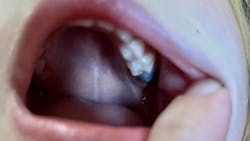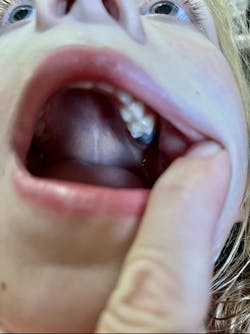Eruption cysts: Symptoms and recommendations for pediatric dental patients
In honor of National Children’s Oral Health Month, let’s consider a symptom found in pediatric patients’ mouths that is not commonly discussed: eruption cysts. An eruption cyst (EC) is a sac formed when primary or permanent dentition pushes into the gingival tissue. ECs are defined by the World Health Organization as a type of dentigerous cyst that involves no bone and lies in the soft tissue.1
Presentation of eruption cysts
An EC often looks like a swollen blue to purple (or even black-covered) lump in the patient’s mouth.1,2 The cyst can be filled with clear liquid or blood.1 Unfortunately, parents, caregivers, and patients may become overly concerned when they suddenly notice this lump.
What causes eruption cysts?
While scientists haven’t been able to determine why some pediatric patients develop ECs and some do not, many hypotheses include lack of space, trauma, caries, infection, and genetics.1,2 Infants, toddlers, preschoolers, elementary-aged children, and even teenagers can develop an EC, but the average age seems to be seven years old.2 There is also a discrepancy in whether or not males are more commonly predisposed to ECs than females; at present, a direct relationship has not been determined.1
Researchers have tried to isolate which tooth in the oral cavity is most likely to have an EC form during its eruption. Some research has stated that mandibular molars often have ECs; other scientists argue that incisors are the most common.1,2 Studies have also recorded ECs on canines and premolar teeth.1
Also by the author … Chlorhexidine mouthwash: Still the best choice for dental patients?
Symptoms of an eruption cyst
When an EC occurs, a patient may complain of slight discomfort. Some patients have reported zero symptoms when an EC has formed in their mouth.1,2 Others have reported slight discomfort when they chew.1,2 More often than not, patients, parents, and caregivers are more concerned with the visible features of an EC than how it feels to the patient.1,2
Dental recommendations for eruption cysts
If a patient presents with discomfort, and, after clinical assessment, the dental professional believes the patient is experiencing an EC, they can offer guidance on how to handle the situation. First, gather the patient’s age and symptoms. If the patient is of age when a tooth could be erupting and describes symptoms that sound like those mentioned above, you could diagnose the problem as an EC.
Radiographs will not help with a diagnosis; research shows that ECs often cannot be detected on a radiograph.1,2 Reassure both the patient and parent/caregiver that ECs are harmless and nothing more than “growing pains.”
Also by the author … Oral hygiene instruction: Do your patients understand its importance?
Dental professionals can recommend over-the-counter pain medication or simply rub a topical anesthetic on the area to reduce any symptoms. If the patient is in dire pain, a surgical slit could be made in the cyst sac to help the tooth push further through the gingival tissues.1,2 Most of the time, surgery is not warranted and is seldom performed on ECs.1,2
Establishing routine dental care for pediatric patients is a great way to stay on top of dental eruption patterns and maintain great oral health. Dental professionals should be prepared to answer questions about when a tooth may be getting ready to erupt to forewarn patients, parents, and caregivers that changes are coming.
Editor’s note: This article first appeared in Clinical Insights newsletter, a publication of the Endeavor Business Media Dental Group. Read more articles and subscribe.
References
- Şen-Tunç E, Açikel H, Sönmez IS, Bayrak Ş, Tüloğlu N. Eruption cysts: a series of 66 cases with clinical features. Med Oral Patol Oral Cir Bucal. 2017;22(2):e228-e232. doi:10.4317/medoral.21499
- Nasti AM. Eruption cyst: causes, symptoms, and treatments. Colgate-Palmolive Company. Updated January 9, 2023. https://www.colgate.com/en-us/oral-health/mouth-sores-and-infections/eruption-cyst-causes-symptoms-and-treatments
Tracee S. Dahm, MS, BSDH, RDH, is an adjunct clinical instructor for the North Idaho College School of Dental Hygiene in Coeur d’Alene, Idaho. Tracee also works in private practice and has published in dental journals, magazines, webinars, and a textbook. Her research interests include trends in dental hygiene and improving access to dental care for the underserved. She can be reached at [email protected].
About the Author
Tracee S. Dahm, MS, BSDH, RDH
Tracee S. Dahm, MS, BSDH, RDH, is an adjunct clinical instructor for the North Idaho College School of Dental Hygiene in Coeur d’Alene, Idaho, and she also works in private practice. She has been published in several dental journals, magazines, webinars, and textbooks. Tracee is a key opinion leader on cutting-edge innovations in the hygiene field. Her research interests include trends in dental hygiene, improving access to dental care for the underserved, and mental health. Contact her at [email protected].


